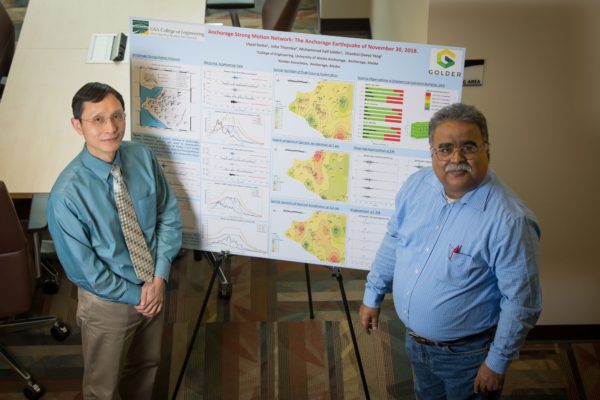UAA announces 2020 ConocoPhillips Arctic Science and Engineering Endowment Award recipients
by Michelle Saport |
As the nation's only Arctic state, Alaska faces unique challenges and environmental conditions unlike anywhere else in the United States. Faculty and students at the University of Alaska Anchorage (UAA) are driving research that tackles the Arctic's challenges in practical ways, such as installing seismic sensors to gather data that helps engineers design safer buildings to withstand earthquakes.
Through the ConocoPhillips Arctic Science and Engineering Endowment Awards, the university awarded support to seven exploratory research projects for 2020 totaling more than $500,000.
"ConocoPhillips' generous gift provides continuous support to conduct critical Arctic research," UAA Chancellor Cathy Sandeen said. "These projects focus on applied research that is making an impact on real issues faced by our communities and state. Though faculty-led, many of the projects include undergraduate and graduate student participation, providing valuable hands-on experience solving real-world problems."

Engineering professors Zhaohui (Joey) Yang (left) and Utpal Dutta are working with geological sciences professor Shuvajit Bhattacharya to install seismic sensors in Eagle River and the Mat-Su Valley to collect ground-shaking data from earthquakes where it is not currently available. (Photo by James Evans / University of Alaska Anchorage)
Selected projects must promote and grow the fields of Arctic science and engineering, demonstrate a likelihood of major scientific or engineering impact and strongly connect to community and industry. Programs, research and activities inclusive of Alaska students, communities, projects and opportunities are given priority.
Created in 2008 as part of a $15 million gift from ConocoPhillips Alaska, the endowment provides annual support to Arctic science and engineering programs and research at UAA and is the largest endowment in the University of Alaska system.
The winning projects for fiscal year 2020 include:
Analysis of drill string stick-slip vibration (Jifeng Peng, principal investigator)
In oil and gas drilling, drill strings sometimes experience severe stick-slip vibration,
which can cause drilling tools to fail, creating delays and increasing costs. This
project aims to develop a model to understand torsional stick-slip vibration coupled
with other vibration modes. The model will be applied to case studies of some ConocoPhillips
wells. Logged drilling vibration signals provided by ConocoPhillips will be analyzed
and practical vibration suppression methods explored.
Determination of ice crushing forces on vertical piles with tidal-accreted ice (Scott Hamel, principal investigator; Jon Zufelt and Joseph Jakes, co-investigators)
The Port of Alaska in Anchorage, the linchpin to the state's economic vitality, is
currently undergoing an expansion to meet Alaska's growing needs. Northern shipping
is expected to increase dramatically as the global climate warms, initiating the construction
and expansion of many port facilities in ice-laden Arctic waters. This project includes
field and laboratory testing to measure and characterize the size and strength of
tidal-accreted ice on vertical piles at the Port of Anchorage.
Detection of internal metal loss in pipelines based on magnetostatic force (Oleg Shiryayev, principal investigator; Raghu Srinivasan, Matthew Cullin and Nicolae
Lobontiu, co-investigators)
Internal corrosion is the primary cause of 50% of the largest spills from flow lines
and facility piping in Alaska. Inspections for detection of internal degradation due
to corrosion are time consuming, costly and potentially dangerous for field crews.
Researchers have demonstrated a proof-of-principle for a new sensing solution that
addresses this problem. The project aims to develop a new sensor design, increasing
detection range so that it is suitable for application on pipes used in oil and gas
facilities.
Filling major data gap in Southcentral Alaska for assessment of seismic risks considering
frozen ground effects (Utpal Dutta, principal investigator; Joey Yang and Shuvajit Bhattacharya, co-principal
investigators)
The Nov. 30, 2018, Anchorage Earthquake strongly impacted Southcentral Alaska, particularly
Eagle River and the Mat-Su Valley. The seismic sensor network, installed about 15
years ago by UAA researchers Dutta and Yang, provided valuable data for engineers
and city planners to analyze. This project aims to install five seismic sensors at
selected sites in Eagle River and the Mat-Su Valley to collect ground-shaking data
from earthquakes where it is not currently available.
Follow the water: Exploring hydrological connections between glacier meltwater and
permafrost in the Alaskan Arctic (Eric Klein, principal investigator; LeeAnn Munk, co-investigator)
Arctic Alaska is experiencing dramatic shifts associated with climate change. Two
important Alaska Arctic systems experiencing change are permafrost and glaciers. Permafrost
in Arctic Alaska is thawing and the active layer depth is increasing. Increased storage
of glacier meltwater in Arctic Alaska surface soils has several critical implications
regarding global sea levels, permafrost thaw, global temperatures and atmospheric
carbon balance. This project aims to explore the hydrologic connections between glacier
meltwater and permafrost.
Measuring aerosol chlorides for atmospheric corrosion studies in cold Alaska climate (Raghu Srinivasan, principal investigator)
Environmental parameters such as temperature, rainfall and humidity affect the rate
of atmospheric corrosion on various alloys. Atmospheric corrosion impacts infrastructure
and has safety and economic implications. Two important factors that affect atmospheric
corrosion rates are aerosol chlorides and time of wetness. This project will measure
aerosol chloride in four different Alaska environments and correlate the chloride
deposition rate with the corrosion rate of metal samples exposed to the same period.
Oxyhydrocarbon detection in petroleum-contaminated surface waters (Patrick Tomco, principal investigator)
Spilled petroleum products may have certain fluorescence characteristics when breakdown
oxidation products are formed. Researchers will create simulated spills in the laboratory,
oxidize the spills to create oxyhydrocarbons, monitor fluorescence wavelengths and
then produce a custom field-deployable sensor tuned to detect the developed wavelengths.
The sensor will be uniquely suited to detect a broader range of dissolved petroleum
compounds spilled by Alaska fuel products in the Alaska environment after exposure
to Alaska's weather conditions.
 "UAA announces 2020 ConocoPhillips Arctic Science and Engineering Endowment Award recipients" is licensed under a Creative Commons Attribution-NonCommercial 4.0 International License.
"UAA announces 2020 ConocoPhillips Arctic Science and Engineering Endowment Award recipients" is licensed under a Creative Commons Attribution-NonCommercial 4.0 International License.









